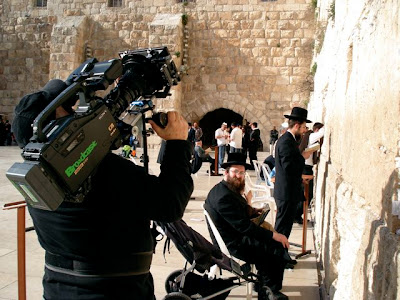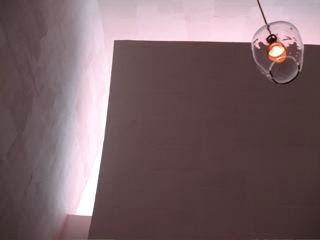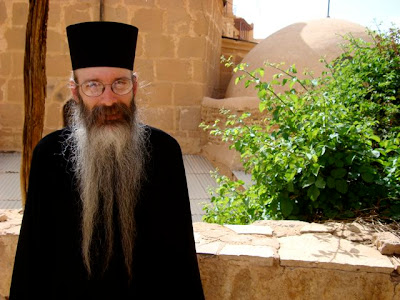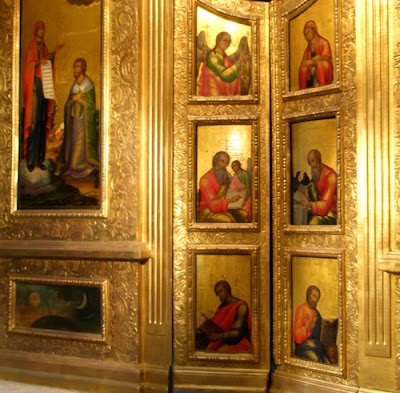Sunday March 2 - Thursday March 6,
Jerusalem, Israel
A national carrier's check-in desk is frequently a microcosm of that nation, and the check-in desk for Israel's El Al Airlines at Heathrow is no exception: "Why are you going to Israel?", "For how long?", "Why have you recently been in Tunisia?" The questions continue, and then the X-rays and searches begin. My hand luggage is taken from me and only returned at the departure gate, and my bags are minutely examined. Fortunately, my father's instruction to "wear my smartest underwear" proves an unnecessary precaution.
It's all mildly irritating. and my schoolboy-before-the-headmaster over-
politesse feels a compromise -- but it's a useful reminder of what I'll face in a few hours, and it's a small price to pay for visiting a country which has long been on my wish-list. The five-hour flight passes quickly and I'm met at
Ben Gurion airport in Tel Aviv and driven to East Jerusalem. The journey takes just under an hour and our fixer, Sharon Schaveet meets me at the hotel.
Employing fixers is a somewhat risky business, and most production web-sites are flooded with the familiar request: "does anyone know of a good fixer in…(name of country here)". Find a poor fixer and the shoot can rapidly deteriorate into farce. Find a great fixer, and you'll start thinking that it's the best money one can spend on a production. Thankfully, Sharon is of the latter school. A wonderfully efficient tour-de-force, she allows nothing to defeat her -- police, soldiers, bureaucrats, crew-members, myself -- we're all cajolled, encouraged, charmed and threatened into line.

In an essential briefing Sharon warns me that the situation is particularly tense at the moment. Israel has launched a major offensive in Gaza and violence has spilled over into Jerusalem. Both Palestinians and Jews are extremely wary. It's going to be a fascinating few days.
My mission to Israel is two-fold. For the Islam film, I'm shooting perhaps the second most significant site (if we regard Mecca and Medina as one) in the Islamic world, the
Dome of the Rock. And for the Judaism film, I'm spending a day at
Masada, capturing one of the few remaining ruins of Second Temple Synagogues. In total I have three days.
Day One and we're blessed with sensational weather: an azure sky, a few clouds and no heat-haze at all. Perfect conditions. I'm picked up at seven in the morning and Sharon introduces me to the rest of the crew: driver Arie, director of photography Ofer and camera assistant Gabi. Later I'll meet the sound-man Nicholas. They're warm, relaxed and enthusiastic about the coming shoot.

The Dome of the Rock is situated on one of the most contested sites in religious history -- a vast ancient platform known to Jews as the
Temple Mount and to Muslims as the Haram al-Sharif or
Noble Sanctuary. In Islamic history, the Rock is the location for the Prophet Mohammed's encounter with the angel Gabriel and his ascension to Paradise, while for Jews, the Temple Mount is the foundation for their holiest of sites, the Davidic Temple.
Although governed by a ruling Islamic body, the Noble Sanctuary is nevertheless carefully monitored by Jewish police. The dynamic between the two nationalities at the gate is fascinating -- my absence of Hebrew or Arabic impedes any thorough insight but the uneasy truce is evident; there is much gesticulating and gesturing, some shouting, appeals for calm, much pointing at the crew and our equipment, occasional laughter and of course lots of guns.
Amid the stand-off is Sharon -- occasionally vociferous, mostly pleading. She's warned us beforehand that anything can happen at the entrance to the Dome of the Rock -- there are no guarantees that we'll be allowed to film, nor for how long. But she keeps on pushing. "She'll call the prime minister next," quips Ofer, awed by her persuasive prowess. She's been negotiating our access with both sets of officials for weeks.

And then suddenly, we're admitted. The crew is asked not to speak Hebrew and we're led inside the Dome of the Rock and into one of the most sacred sites in Islam, to the cave itself where it's believed Mohammed met with Gabriel. The Waqf or ruling Islamic officials have offered us an incredible privilege - filming permission here is very rare, and almost never with a large broadcast camera (we're shooting on HD), let alone a tripod.
We do not have a great deal of time but what we do film is remarkable. After twenty minutes we're hurried upstairs and once again given permission to film the interior of the Dome.We film what we can -- but one could spend days here. The tiling and mosaic glass is exquisite and the designs so varied and complex, mostly patterning but discernible are trees, flowers, vegetation and fruits. In the middle of the dome is the stone roof of the cave but extensive scaffolding hampers our view. There's not enough time -- the call for prayer is approaching and the next minute Sharon tells us that we have to leave the site. I protest, entreating her that we need time to shoot exteriors, but the decision is out of her hands. As quickly as we've arrived, we find ourselves outside the entrance gate.
It has not worked out quite as we'd hoped, although the interior access was remarkable. But without filming the exteriors, we don't have a film. Sharon is concerned too, and we decide to talk everything though over a coffee -- we walk down the
Via Dolorosa. It's my first sight of street-level Jerusalem and I can't help staring: there are Armenian priests, Orthodox Jews, nuns, hawkers, bodyguards, soldiers and of course coachloads of tourists -- the mix of people is astonishing.

Once we've relaxed a little, Sharon says she'll work hard to convince both the Israeli policemen and the ruling Waqf to allow us access for the following day. She refuses to be drawn on whether it's likely but she'll do everything she can. In the meantime, we can spend some time sourcing a suitable roof-top to film the interview with our Islamic expert. We explore various options and eventually decide on the roof of the Austrian Hospice. It affords us a wonderful view of the Dome and we set for the interview.
Dr Marwan Khalaf is an expert in Islamic art and architecture and proves a gentle and knowledgeable interviewee. Among much else, he explains about the evangelistic role of the Dome of the Rock -- it was partly constructed to compete with (and surpass) other religious structures in Jerusalem, and he tells us too about the mathematical symmetry of the Dome -- 4 doors, 8 sides, 16 columns, 52 windows etc. It's a very constructive couple of hours and we end the day with some sunset shots from the Mount of Olives before a 6 o'clock lunch.
Day Two and Sharon has decided that the best thing to do is just to pitch up early at the Dome and try our luck. We squeeze in a sunrise shot first thing and then head to the entrance. Ofer and I exchange ideas about the routine which dominates much of filming -- "Hurry Up and Wait" -- and we shoot some general footage while waiting to hear news of progress. Sharon calls. If we come this minute, she thinks we can get in. She's right and once again we get access. Other crews don't fare so well -- there's a media ban in place and among others, the BBC are turned away.

One of the privileges of filming is the opportunity to look at buildings in significant detail, courtesy of a long lens. And the Dome doesn't disappoint -- the golden cupola steals the headlines but the windows, walls, even guttering are just as remarkable. Again it's a day of blue skies, and the structure looks wonderful. We could spend all day here, and another day too, but we've pushed our luck already and the governing Waqf have indulged our schedule to an incredible degree. We say our thank you's and leave the Dome of the Rock.
Except of course we don't. Just by the entrance of the Noble Sanctuary, two abandoned rucksacks have been identified as suspicious. We and our equipment are held at the gate as an explosives robot rumbles into action. We're ushered out of the sight-line and hear six muffled shots -- the sound of the robot shooting the packages. Predictably the rucksacks prove to be only that, but the situation doesn't help tension levels.

A coffee later, and we're filming street scenes, market scenes and Jerusalem establishing shots. Our final location for the day is the
Western Wall -- often referred to as the wailing wall. It's one of those scenes with which one has become so familiar, but up close, the whole experience is of course far more vivid. We film right by the wall and I feel a touch uncomfortable at our proximity to the worshippers. Not so Ofer and, seemingly, not so the Orthodox Jews who continue, indifferent to our presence. The early evening is spent having dinner at Restobar. "Oh this place," remarks the camera assistant, Gabi, "you may remember, it was decimated by a suicide-bomber a couple of years ago."

Day Three and leaving Jerusalem behind us, we're driving alongside the Dead Sea on our way to Masada. Ever since seeing Peter O Toole in the
1981 mini-series of the siege, I've wanted to come here, probably along with many thousands of others.

The story of Masada is an extraordinary one. In 66 CE a group of rebels from a Judaic extreme sect, the Sicarii, surprised and overcame the Roman garrison at Masada. With cliffs rising 400 metres above the desert, the site offered a near impregnable natural fortress (complete with huge food stocks and its own well). In turn, the Romans besieged Masada, constructing a vast rampart which enabled the defenses to be breached. When the Romans entered the fortress in 72 CE, they discovered that all 936 inhabitants had committed suicide rather than face captivity. Dramatically symbolic, Masada is now Israel's second most popular tourist site.

Our focus for the day is Masada's synagogue. Not much remains - a few broken walls, pillars and the steps bordering the walls where worshippers would sit, pray and listen to readings of the Torah. A converted stable, the building is incredibly simple and pure; a rejection of the rich colour-schemes and ornate construction of the surrounding Roman buildings. Nevertheless, I find it beautiful -- concise, straightforward and modest.
Archaeological expert Avner Goren is our guide. He's a fabulous contributor -- experienced in the trials of television, he's both patient and charismatic, content to wait in the sun while we tinker with our set-ups. He draws a vivid account of the siege and is alive to contemporary parallels with Gaza. He also highlights the fact that for many Israelis, Masada is a symbol with which they no longer wish to be closely allied -- they don't want to be isolated from other communities or nationalities; instead they want actively to engage with them.

We film until 4pm and then catch the final cable car down the slopes. A few last sunset shots over the desert and we drive back to Jerusalem. One last supper and a flight home. At the hotel, I'm asked whether, for the journey to the airport, I'd prefer a Jewish taxi-driver or a Palestinian taxi-driver. Only in Israel. (Seb Grant)
 The last few days have been extraordinary. My colleague John Wyver and I have met more than sixty young artists during whirlwind casting sessions in New York and Los Angeles. We've been trying to find two artists with sufficient bravura and artistic merit to feature in a forthcoming television series called Art Race. The premise of the show is simple: is it possible to cross the USA on a single dollar, surviving only on art? We think we've cast the right artists -- but that's another blog.
The last few days have been extraordinary. My colleague John Wyver and I have met more than sixty young artists during whirlwind casting sessions in New York and Los Angeles. We've been trying to find two artists with sufficient bravura and artistic merit to feature in a forthcoming television series called Art Race. The premise of the show is simple: is it possible to cross the USA on a single dollar, surviving only on art? We think we've cast the right artists -- but that's another blog. I'm in Seattle, Washington to film the final building of the Christianity film, the Chapel of St.Ignatius on the Seattle University campus. Designed by local wonder-architect Steven Holl, the building is acclaimed as an incredible exercise in shade and light or as Holl describes it, "seven bottles of light in a stone box". Sniffily, I begin to wonder whether his claim might only be empty "architecture-speak"
I'm in Seattle, Washington to film the final building of the Christianity film, the Chapel of St.Ignatius on the Seattle University campus. Designed by local wonder-architect Steven Holl, the building is acclaimed as an incredible exercise in shade and light or as Holl describes it, "seven bottles of light in a stone box". Sniffily, I begin to wonder whether his claim might only be empty "architecture-speak" Father Cobb explains the building's genesis (from a water-colour by Holl) and then lays out the broad brush-strokes of the building's design -- the basic procession from grassy lawn to reflecting pool and on to the chapel itself. This is a natural flow which embraces the campus while simultaneously preparing the Catholic congregation for worship.
Father Cobb explains the building's genesis (from a water-colour by Holl) and then lays out the broad brush-strokes of the building's design -- the basic procession from grassy lawn to reflecting pool and on to the chapel itself. This is a natural flow which embraces the campus while simultaneously preparing the Catholic congregation for worship. It's not until we enter the building that the building's true beauty is revealed. Time magazine described Holl recently as "the best architect working in America" and the accolade appears justified when one has the time to spend in any of his interiors. I should confess to being an enormous Holl fan -- during two series of Artland, our recent cultural road-trip through America, we visited several of Holl's creations including the fabulous Bloch Building at the Nelson Atkins Museum of Art in Kansas. Each one has surprised me with its tireless invention and sense of play.
It's not until we enter the building that the building's true beauty is revealed. Time magazine described Holl recently as "the best architect working in America" and the accolade appears justified when one has the time to spend in any of his interiors. I should confess to being an enormous Holl fan -- during two series of Artland, our recent cultural road-trip through America, we visited several of Holl's creations including the fabulous Bloch Building at the Nelson Atkins Museum of Art in Kansas. Each one has surprised me with its tireless invention and sense of play. Evident in the St. Ignatius chapel are the seven "bottles of light" which Holl writes about: pools of light refracted through coloured windows, a sort of re-imagining of more classical stained-glass. And consistent with the Bloch Building, it appears impossible to count the interior surfaces -- there are no two alike in the entire space.
Evident in the St. Ignatius chapel are the seven "bottles of light" which Holl writes about: pools of light refracted through coloured windows, a sort of re-imagining of more classical stained-glass. And consistent with the Bloch Building, it appears impossible to count the interior surfaces -- there are no two alike in the entire space. The afternoon comes and we have a wedding to film. The bride and groom have kindly allowed us to film during the ceremony and the run-up to the service too. I'm rather fascinated to see that this side of the Atlantic the wedding photos take place before the ceremony. I also can't help thinking that the wedding guests must believe we're the scruffiest, laziest wedding videographers they've ever seen (particularly as we have to wrap before the exchange of vows).
The afternoon comes and we have a wedding to film. The bride and groom have kindly allowed us to film during the ceremony and the run-up to the service too. I'm rather fascinated to see that this side of the Atlantic the wedding photos take place before the ceremony. I also can't help thinking that the wedding guests must believe we're the scruffiest, laziest wedding videographers they've ever seen (particularly as we have to wrap before the exchange of vows). Finally, there's just the opportunity to sneak round the university's art collection. Father Cobb curates the acquisitions and has built up a modest, but impeccably chosen array which is presented to be as accessible as possible for the students. I leave campus with two lovely memories; firstly, the interior of the St. Ignatius chapel, and secondly a student in the campus canteen, tucking into his lunch, perhaps regardless of the priceless Chuck Close portrait just above him. (Seb Grant)
Finally, there's just the opportunity to sneak round the university's art collection. Father Cobb curates the acquisitions and has built up a modest, but impeccably chosen array which is presented to be as accessible as possible for the students. I leave campus with two lovely memories; firstly, the interior of the St. Ignatius chapel, and secondly a student in the campus canteen, tucking into his lunch, perhaps regardless of the priceless Chuck Close portrait just above him. (Seb Grant)















































